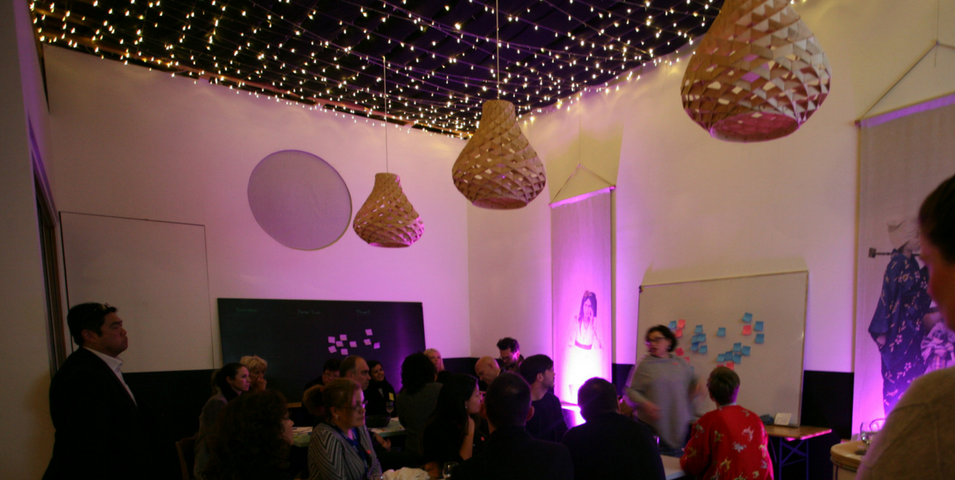
On Wednesday, 4 July 2018, Ellis Jones and innovAGEING brought together 25 executives, referral organisations, designers, architects, researchers and academics from across the aged care sector. In Ellis Jones’ Realm of Possibilities workshop space, people rolled-up their sleeves and got out of their comfort zone for our event – Design for social innovation. The future of aged care.
The Ellis Jones team set the scene for the evening by challenging participants to get hands-on with the techniques. The focus, they said, was on exploring the challenges and opportunities for innovation in aged care to deliver shared value – that is enhancing competitiveness and delivering profits in ways that positively impact health and well-being outcomes for older Australians and their families.
The opportunity presented by design thinking approaches.
“Design Thinking is the method and process that provides a toolbox of skills to creatively and laterally solve problems together. Human Centred Design is the opportunity to apply these processes in ways that put people at the centre of the outcomes we design, be that business models, products or service delivery.
The aged care market provides an unparalleled opportunity to apply design thinking methods. The delivery of services and the nature of the market is such that the only way is the personal way.” David Constantine, Design Director, Ellis Jones.
Following an introduction to the application of design thinking and human centred design approaches in aged care, attendees heard from Dee, a family member with an older parent beginning their aged care journey. Considering Dee’s context, the challenge was set to frame, understand, design and test opportunities the address the pain points at an individual or family members initial interactions with aged care, through four short lab sessions applying a number of design thinking techniques including storytelling, the ‘five whys’, storyboarding, Lego play and role-play activities.
Here’s a snapshot of challenges, opportunities and potential solutions shared over the evening:
Making complex conversations meaningful – balancing the needs of the individual with the needs of family members.
The initial conversations aged care providers have with individuals and family members are fraught with complexities. With a number of residential aged care managers and in-home care client services leads present, a key question was raised: how do we balance the emotional and informational needs of both the older person and their family during initial meetings?
Calling on both personal and professional experience, the group acknowledged that it was vital to direct conversations to the older person themselves. A practice that can be difficult when family members have divergent expectations or, especially in the context of residential aged care, are the primary decision maker. Aged care managers face the difficult situation of providing emotional guidance, as well as conveying complex information around services, cost and funding.
While hosting a series of meetings with family members and older people, both individually and together, provides the best opportunity to improve the initial experience of aged care, there are a number of barriers to implementation including immediate health concerns and provider resourcing pressures. Design thinking method provides opportunities for providers to map out scenarios with consumers to make continued improvements and provide staff and management training around the initial interactions.
Flexible models of care – reablement and re-entry into the community.
To truly enable enhanced well-being outcomes for older people, we need to reconceive the way we see and offer aged care services. In many conversations, the future of residential aged care is framed around the increasing age and complex health conditions of people entering care. A re-conception of residential aged care – as not necessarily the final place, but a place of recuperation and reablement – provides the opportunity for providers to laterally expand services in a way that delivers value.
The application of co-design enables the various companies and influencers in and around the care continuum to link services, innovate and evolve the market in the way that better meets individual and community well-being outcomes.
Disrupting aged care the path to care – from linear to circular models of advice.
Aged care is complex and challenging, and people enter and interact with the aged care system at different points and places during their lives. As the sector looks to ways to better inform people about their aged care options and support them as they make decisions, we have to consider that many people will bypass these traditional information channels and there first interaction with the aged care system will be at a time of crisis.
Human centred approaches to design offer the potential for industry disrupters and innovators, such as Care Page, to design and evolve solutions for 360-degree advice and support – linking people with the right information, at the right time.
Following an insightful and enjoyable evening, the final note was that we – providers, government, peak bodies, advisors, researchers, in fact everyone involved and invested in the aged care system – need to be looking to the future. While we need to respond to the challenges and opportunities presented by a sector that is going through significant reform, we need to be looking out 30 years from now and innovating around future services. Changing the narrative, and engaging people around the positive impact of aged care now and into the future is key to building a strong and sustainable system.

